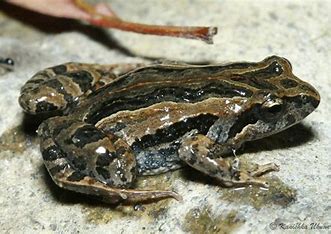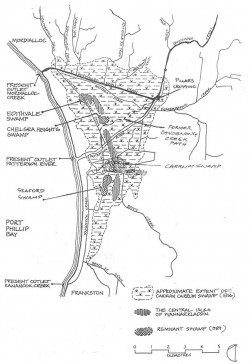 Pobblebonk Frog
Pobblebonk Frog
Update-Frogs!
There are five different frogs associated with Edithvale-Seaford Wetlands.
They are seldom seen but they can be heard.
Listen to their calls here so you can identify them when you visit the wetlands:
- Images and Audio courtesy Melbourne Water -
Your browser does not support viewing this document. Click here to download the document.
General Information
To see a map of the wetlands, please refer to Current Wetlands Map on the Home page.
Wetlands are among the most productive and most threatened ecosystems in the world.
Over 100 different species of birds can regularly be seen at Edithvale-Seaford Wetlands.
In March 1996, the Edithvale-Seaford Wetlands were nominated by the Australian Government for listing under the Convention on Wetlands of International Importance, which is commonly known as the Ramsar Convention.
Seventeen species of migratory birds from the northern hemisphere visit the Edithvale-Seaford Wetlands. Most of them are protected by international treaties.
Seven thousand years ago the Edithvale-Seaford Wetlands were under the waters of Port Phillip following the melting of the last Great Ice Age.
Before white settlement, Edithvale-Seaford Wetlands were thick with wildlife and supported large numbers of the Bunerong Aboriginal tribe.
Edithvale Wetlands currently support a thriving mob of Eastern Grey Kangaroos.
Not many years ago, the Edithvale-Seaford Wetlands were generally considered useless swamps too difficult to develop. Today they are recognized as precious community assets.
The Friends of Edithvale-Seaford Wetlands Inc were formed in 1988 and have been responsible for making many improvements, including the planting of thousands of trees.
Below are some illustrations that may assist in understanding various aspects of the wetlands including helping explain the alluvial plains associated with the wetlands and the drainage patterns (many thanks to Scott Seymour for providing these):
Wetlands are among the most productive and most threatened ecosystems in the world.
Over 100 different species of birds can regularly be seen at Edithvale-Seaford Wetlands.
In March 1996, the Edithvale-Seaford Wetlands were nominated by the Australian Government for listing under the Convention on Wetlands of International Importance, which is commonly known as the Ramsar Convention.
Seventeen species of migratory birds from the northern hemisphere visit the Edithvale-Seaford Wetlands. Most of them are protected by international treaties.
Seven thousand years ago the Edithvale-Seaford Wetlands were under the waters of Port Phillip following the melting of the last Great Ice Age.
Before white settlement, Edithvale-Seaford Wetlands were thick with wildlife and supported large numbers of the Bunerong Aboriginal tribe.
Edithvale Wetlands currently support a thriving mob of Eastern Grey Kangaroos.
Not many years ago, the Edithvale-Seaford Wetlands were generally considered useless swamps too difficult to develop. Today they are recognized as precious community assets.
The Friends of Edithvale-Seaford Wetlands Inc were formed in 1988 and have been responsible for making many improvements, including the planting of thousands of trees.
Below are some illustrations that may assist in understanding various aspects of the wetlands including helping explain the alluvial plains associated with the wetlands and the drainage patterns (many thanks to Scott Seymour for providing these):
Edithvale Seaford Wetlands

The Edithvale–Seaford Ramsar Site comprises two wetland systems, Edithvale Wetlands and the Seaford Wetlands. The combined area of the two swamps is 261 ha, the wet bits being 116 ha and is about 25 Kms south east of Melbourne
Within the boundary of the Ramsar site are sensitive wetland habitats as well as public and recreation areas.
Within the boundary of the Ramsar site are sensitive wetland habitats as well as public and recreation areas.

Edithvale Wetlands, is about 103 ha and is made up of the constructed ‘Dog Ponds’ on the Northern side of Edithvale Road and the main swamp south of Edithvale Road.
Seaford Swamp occupies approximately 158 ha and is situated east of Seaford behind Kananook Creek and the Seaford Foreshore
The Edithvale–Seaford Wetlands are one of the last remaining representative example of the once expansive Carrum Carrum Swamp, which stretched from Mordialloc to Frankston. Much of the 4319 ha swamp was drained in the 19th Century so that now there remains only a string of wetlands.
Seaford Swamp occupies approximately 158 ha and is situated east of Seaford behind Kananook Creek and the Seaford Foreshore
The Edithvale–Seaford Wetlands are one of the last remaining representative example of the once expansive Carrum Carrum Swamp, which stretched from Mordialloc to Frankston. Much of the 4319 ha swamp was drained in the 19th Century so that now there remains only a string of wetlands.

Although suburbia now surrounds both Edithvale and Seaford Wetlands and the water bodies have both been modified, the basic characteristics of the Carrum Carrum Swamp system still exist.
Since white settlement the hydrology of the wetlands have been modified which in turn has changed the types of vegetation that grow in and around the water bodies. This altered vegetation in turn dictates the types of birds that use certain areas of both Wetlands.
Being within close reach to residents and schools, the wetlands are an outdoor classroom as well as a mecca for birdwatchers.
Since white settlement the hydrology of the wetlands have been modified which in turn has changed the types of vegetation that grow in and around the water bodies. This altered vegetation in turn dictates the types of birds that use certain areas of both Wetlands.
Being within close reach to residents and schools, the wetlands are an outdoor classroom as well as a mecca for birdwatchers.

The original inhabitants of the region, the Bunarong Tribe would have used these wetlands as they moved around the land. There would have been seasonal abundances of eggs, birds, kangaroos and doubtless many edible plants. Although only one site of scattered implements have been found it most likely would have been an important meeting place for ceremonies and feasts.
Nowadays the Edithvale/Seaford Wetlands are an essential component of the regional drainage system, coping with road run off and local storm water. Although it has been dry for over a decade the wetlands have the capacity to deal with floodwaters to protect properties down stream.
Nowadays the Edithvale/Seaford Wetlands are an essential component of the regional drainage system, coping with road run off and local storm water. Although it has been dry for over a decade the wetlands have the capacity to deal with floodwaters to protect properties down stream.

The Edithvale–Seaford Wetlands are a fantastic habitat for a diverse range of waterbirds with seventy-five native waterbird species being recorded at the Ramsar site between 1989–2007.
The Edithvale-Seaford Wetlands Ramsar Site: Management Plan. Report prepared for Melbourne Water by Kellogg Brown & Root Pty Ltd, Melbourne. States ….”The diversity of native waterbird species recorded at the site allows the Edithvale–Seaford Wetlands to satisfy Ramsar Criterion Three in addition to the criteria met at the time of listing. The wetlands provide foraging habitats for seasonal populations of a number of migratory waders. As noted above, 25 bird species listed under CAMBA and 25 species listed under JAMBA have been recorded within the wetlands.
The Edithvale-Seaford Wetlands Ramsar Site: Management Plan. Report prepared for Melbourne Water by Kellogg Brown & Root Pty Ltd, Melbourne. States ….”The diversity of native waterbird species recorded at the site allows the Edithvale–Seaford Wetlands to satisfy Ramsar Criterion Three in addition to the criteria met at the time of listing. The wetlands provide foraging habitats for seasonal populations of a number of migratory waders. As noted above, 25 bird species listed under CAMBA and 25 species listed under JAMBA have been recorded within the wetlands.
Of particular note, the Edithvale–Seaford Ramsar site regularly supports more than 1 per cent of the East Asian-Australasian Flyway population of sharp-tailed sandpiper, a waterbird species of international importance listed under both JAMBA and CAMBA. The East Asian-Australasian Flyway extends southwards from Alaska and Russia’s far-east, through East Asia and South-East Asia, to Australia and New Zealand. The wetlands provide suitable habitat for the sharp-tailed sandpiper as they prefer shallow, freshwater, ephemeral wetlands. Large numbers gather at the Ramsar site as the wetlands dry out.
The ability of the wetlands to regularly support more than 1 per cent of the flyway population of sharp-tailed sandpipers enabled the site to satisfy Ramsar Criterion Six at the time of listing.
The Edithvale–Seaford Ramsar site also provides suitable habitat for the regularly recorded Australasian bittern, a waterbird species of international significance. The Australasian bittern is listed as endangered by the International Union for Conservation of Nature and Natural Resources. The south-east Australian population of Australasian bitterns, supported by Edithvale–Seaford Wetlands, is one of four remaining in the world. Preferred habitat includes permanent, shallow, freshwater or brackish swamps with tall, dense vegetation, the Australasian bittern benefits from the high water levels at Edithvale–Seaford Wetlands over the winter-spring period.”
The ability of the wetlands to regularly support more than 1 per cent of the flyway population of sharp-tailed sandpipers enabled the site to satisfy Ramsar Criterion Six at the time of listing.
The Edithvale–Seaford Ramsar site also provides suitable habitat for the regularly recorded Australasian bittern, a waterbird species of international significance. The Australasian bittern is listed as endangered by the International Union for Conservation of Nature and Natural Resources. The south-east Australian population of Australasian bitterns, supported by Edithvale–Seaford Wetlands, is one of four remaining in the world. Preferred habitat includes permanent, shallow, freshwater or brackish swamps with tall, dense vegetation, the Australasian bittern benefits from the high water levels at Edithvale–Seaford Wetlands over the winter-spring period.”

Unfortunately the vegetation rates a second best to the birds, but it is vital for the survival of so many bird, insect, reptile and fish species. Over the year as the water levels change in the Wetlands so does the type of vegetation. Autumn is when a lot of the tall reeds flower and set seed, the marshy plants grow, flower and form corms under ground as a later food source for many birds. The wetlands are always changing.
Wetlands are not always wet! At the end of Summer the wetlands start to dry out... many people think this is sad as most of the birds leave, but this is the time of the year when the wetlands renew themselves. The Bolboschoenus (green reeds) emerge, flower and make new corms under the ground for the Swamphens to eat later on. Various smaller plants flower and set seed before it gets too wet again. Once all of these plants have grown, they die off again and as they rot down this adds nutrient to the wetlands and the whole cycle starts again.

The Edithvale Wetlands are also home to a population of Eastern Grey Kangaroos that were introduced in 1985. The original population of 7 was not meant to increase as the dominant male was sterile, but the younger buck took a girlfriend off to the other end of the swamp and the population started to increase. Unfortunately the population grew to such high numbers that a Management Plan is now in place to protect the animals from overpopulation and running out of food.

Every month a team of dedicated birdwatchers do a bird count on both Seaford Wetlands and the Edithvale Wetlands. The count is done at the same time each month and figures logged on a data sheet. During the spring and summer months the counts are usually quite high and normally migratory waders are at one or other of the wetlands. In the drier winter months the bird count can be quite low and at times very tedious. There are several locations where smaller bush birds are caught and banded. Data from both the counts and banding has allowed a greater understanding of what is happening in the wetlands and how the birds are reacting to certain changes, either in climate or vegetation variations.

Frankston City Council has recently acquired an additional parcel of land occupying 20.8 ha, ‘Downs Estate’, which adjoins the north-eastern corner of Seaford Swamp. This parcel of land is currently situated outside the Ramsar boundary.








